Iceland’s Blue Lagoon – Your Complete Guide
March 23, 2022
Iceland’s Blue Lagoon – Your Complete Guide
March 23, 2022
Out in the volcanic landscape of the Reykjanes Peninsula, an ethereally blue geothermal lagoon awaits. People have been flocking to the warm waters since 1981 to heal their ailments and unwind weary muscles and it’s now one of Iceland’s top activities. Blue Lagoon tours head to this beautiful site, so you can enjoy an iconic Iceland experience without having to worry about logistics. Blue Lagoon tours in Iceland leave from Reykjavik or Keflavik Airport, or can be incorporated as part of a day of sightseeing. Whether you’re visiting for a stopover between continents or here to enjoy Iceland’s unique scenery in-depth, don’t leave without experiencing the geothermal waters of the Blue Lagoon. Here’s everything you need to know about it.
What is the Blue Lagoon?
Catching a glimpse of the milky-blue water against the black-rock lava fields, it may not come as a complete surprise that the Blue Lagoon is man-made. Runoff water from the nearby Svartsengi geothermal power plant trickles into the lava fields and a blanket of mineral-rich mud lines the foundations of the Blue Lagoon. This creates a heavenly bathing experience with water at a consistently pleasant temperature said to rejuvenate body, soul and skin.
You can find the Blue Lagoon a forty-five-minute drive from Reykjavik, close to Keflavik Airport on the Reykjanes Peninsula. There are plenty of activities and amenities to keep you occupied for hours – restaurants, shops, spa experiences, steam rooms and, of course, soaking in the lagoon itself.
Facts About The Blue Lagoon
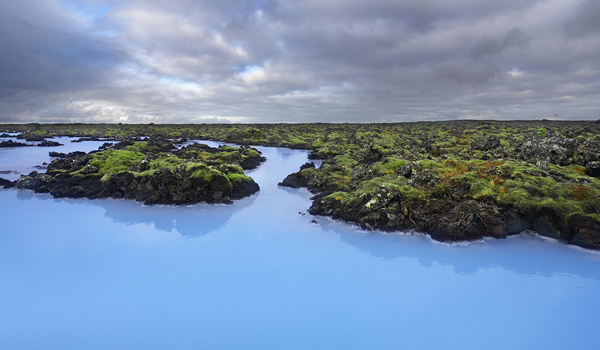
History of the Blue Lagoon
When the Svartsengi geothermal power plant opened in 1976, the engineers assumed that the runoff water would simply be absorbed by the porous volcanic rock around the site. Instead, a mineral-rich bed of mud settled and heated water turned milky-blue with silica pooled to create an other-worldly lagoon.
When local people started bathing here in the 1980s, there were no changing facilities or showers and they would just change in their car or brace the open air before slipping into the geothermal water. Rumours of the healing powers of the lagoon soon spread – those with psoriasis swore it healed their skin. Even people without an affliction said they emerged fresh and baby-skinned from the warm lagoon.
1992 saw the Blue Lagoon Company officially emerge and bathing here was so popular that changing facilities and showers were added. When the power plant was moved, so was the lagoon and new facilities were built, turning this place into a luxurious spa-like experience with fine-dining restaurants, research facilities and even a hotel.
Can you swim in the blue lagoon?
The Blue Lagoon experience is designed as a relaxing spa day where you submerge yourself in the bath-warm water and simply unwind. Although you can perhaps swim a couple of leisurely breaststrokes, it’s not suitable for vigorous exercise and too shallow to dive into. In fact, you can always touch the bottom of the lagoon standing up, so it is not like a swimming pool. The milky-blue depths aren’t clear either, so you only really want to stick your head under the water to keep warm or perhaps wash off your mud mask.
What temperature is the Blue Lagoon?
The geothermal water is between 37° and 40° C (98-104°F) but can sometimes fluctuate beyond that range. It is, essentially, the temperature of a hot tub or a warm bath. Once you’ve sat in the lagoon for an hour or so, hydrating with a bottle of water is recommended.
Does the Blue Lagoon have healing properties?
In the past, people suffering from psoriasis in varying degrees have sworn it has helped them with their disease. These claims have become more than just rumours over the years – the Blue Lagoon Company has an extensive archive of academic papers, with decades of research confirming that geothermal seawater is effective in treating psoriasis. Silica in the water is particularly good at absorbing oil, so is said to help with eczema and acne too. The Blue Lagoon geothermal spa is even officially approved by Iceland’s National Health Service as psoriasis treatment.
Silica Hotel offers psoriasis treatment packages, with floating sessions in a private lagoon supervised by a dermatologist and nurse followed by UVB light therapy and Blue Lagoon skincare products.
Skincare At the Blue Lagoon
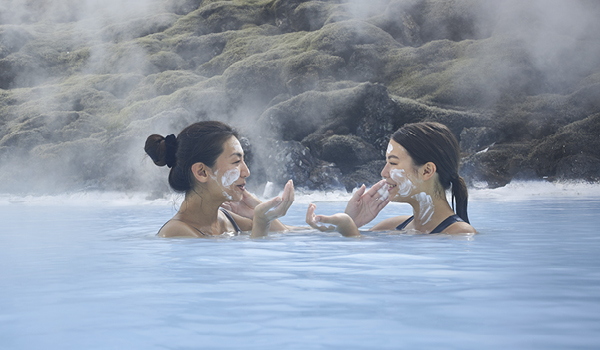
Most visitors to the Blue Lagoon indulge in a mud mask as they bathe, and the Reykjavik Excursions’ Blue Lagoon Comfort and Premium Tours include a silica and algae mud mask, rejuvenating your skin and leaving it firmer and feeling softer. Simply slipping into the warm water and spending time soaking is said to leave skin radiant, youthful and healthy.
The Blue Lagoon Company has distilled and bottled the bioactive minerals of the mud and water. Their skincare range features algae and silica masks, serums and moisturisers so you can take a little sample of the Blue Lagoon home with you. If you forget to pick up some skincare products at the lagoon itself, don’t worry, they have shops in the centre of Reykjavik and at Keflavik Airport too.
The Blue Lagoon Experience
Most people spend between two and three hours at the Blue Lagoon, but if you want to take advantage of all the facilities you can spend longer. You’ll need to bring your own swimwear, and towels can be rented (or are included in a Reykjavik Excursions Blue Lagoon trip). Lockers are available to store your belongings while you bathe.
Once you’ve changed in the changing rooms and showered, slip into the warm water and enjoy a litany of amenities. Perhaps grab a smoothie, beer or glass of wine at the in-water bar, or pick up a mud mask from the in-water mask bar.
There’s a grotto-like steam room carved into the volcanic rock and a sauna too. Geothermal, natural steam opens up the pores and is a welcome respite from the cold in winter. If you really want to indulge, opt for an in-water massage or perhaps unwind with some float therapy. Add in a lavish meal at one of the fine-dining restaurants on top of your spa experience and you could spend the best part of a day here.
Best Time To Visit The Blue Lagoon

The thermal waters stay warm year-round, so really there’s no bad time to visit the Blue Lagoon. There’s something particularly magical about soaking in the hot water as snow falls and the Northern Lights dance above you. After a morning of sightseeing in the cold Icelandic winter, there’s nothing better than a long soak in a thermal lagoon. The longer opening hours in summer, when the sun barely dips below the horizon, allow you plenty of time to enjoy every aspect of the lagoon.
Generally, the Blue Lagoon is open all day. Opening hours do vary by season, based on weather and sunset, and are as follows:
January-May from 09:00-21:00
June from 08:00-22:00
July-August from 08:00-23:00
September from 08:00-22:00
October-December from 08:00-21:00Eating at the Blue Lagoon
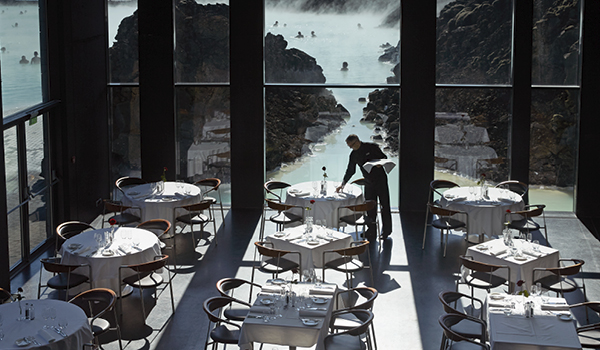
There are three different dining options to choose from at the Blue Lagoon. Moss is perhaps the most refined and boasts a mention in the Michelin guide. The seasonal tasting menu changes as produce in the surrounding area ripens and is harvested. In winter, a fire blazes away in the stove at the centre of the dining room and the view is over the volcanic horizon. A set tasting menu is served like works of art on a plate – think sweeps of jus around perfectly pink cuts of lamb and scallops seared to perfection. There’s a vegan menu here too.
Lava Restaurant is another refined option with an interior hewn into an old lava cliff. A menu of traditional Icelandic cuisine is served gourmet-style, based on the finest, freshest local ingredients. Perhaps start with a garlicky langoustine soup, followed by the fresh fish of the day (landed locally at Grindavik harbour) for main. The skyr and blueberries is a healthy yet sweet way to end the meal, and it’s all paired with a view of the Lagoon as you dine. If you really want to indulge, there’s a tasting menu here too. The Blue Lagoon Premium Package includes a reservation and sparkling wine at Lava Restaurant, if you are dining.
Feed your body and soul at the Spa Restaurant, where reservations aren’t necessary. The atmosphere is a bit more laid back (it is a spa after all) – you can dine in your robe here and no one will bat an eyelid. The view is out over the Lagoon from floor-to-ceiling windows and the menu serves up healthy, wholesome food from across the globe. Think umami-rich miso soup or sea-fresh ceviche, and perhaps a refreshing hit of Icelandic berries for afters.
How To Get To The Blue Lagoon
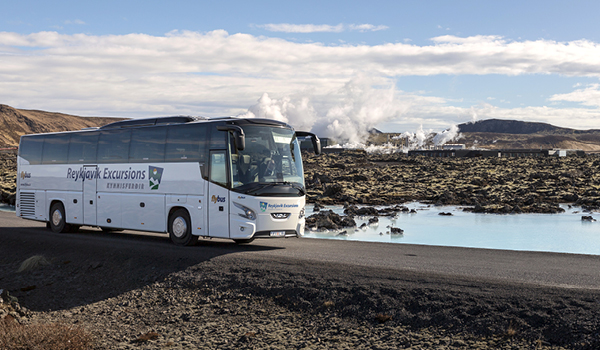
Reykjavik Excursions run a number of Blue Lagoon trips, where transfers from Reykjavik (or even Keflavik Airport) are included. If you’ve got a late flight, you can include a visit to the Blue Lagoon in your airport transfer, hopping on the bus at Reykjavik, spending a few hours soaking in the lagoon and then transferring on to the airport for your flight.
From Keflavik Airport
If you’re arriving early into Iceland, the Blue Lagoon is just 25km from Keflavik Airport so a 20-minute transfer can see you at the lagoon straight from your flight. Slipping into the warm water, surrounded by moss and lava is the perfect tonic after a long flight and an ideal introduction to Iceland’s unique landscape. Reykjavik Excursions have a few options from Keflavik Airport, whether you’re looking for an inclusive comfort or premium package with admission included, or just transfers.
Blue Lagoon Comfort Package from Keflavik Airport
Blue Lagoon Premium Admission from Keflavik Airport
Blue Lagoon Transfer from Keflvaik Airport
From Reykjavik City Centre
From Reykjavik, it’s a 50-minute bus journey to the Blue Lagoon and Reykjavik Excursions run day trips to the Blue Lagoon with admission, mud masks and towels included or can simply arrange transfers for you. The premium package includes a reservation at Lava Restaurant, or you can opt for a day trip that includes a visit to the Blue Lagoon after you’ve seen the sights of the Golden Circle or hit the Reykjanes Peninsula by ATV, which both depart from Reykjavik.
Blue Lagoon Comfort Package from Reykjavik
Blue Lagoon Premium Admission from Reykjavik
Blue Lagoon Transfers from Reykjavik
Do I Need A Reservation For The Blue Lagoon?
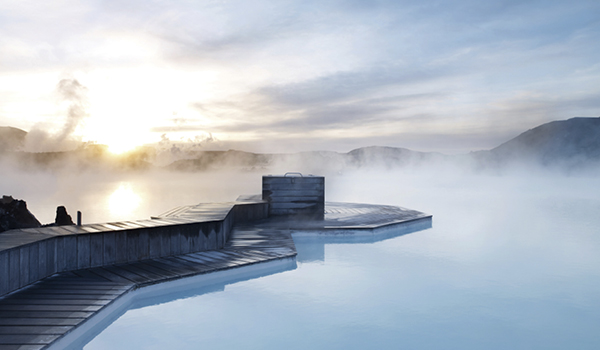
The Blue Lagoon is one of the most popular attractions in Iceland and there are limited spaces every day. Booking in advance is recommended so you don’t miss out on this iconic experience. Reykjavik Excursions offer tours to the Blue Lagoon with towels, mud masks and admission included as well as transfers from Reykjavik or Keflavik Airport. Transfers and tours operate year-round and offer flexible departure times throughout the day.
Popular Attractions Near The Blue Lagoon
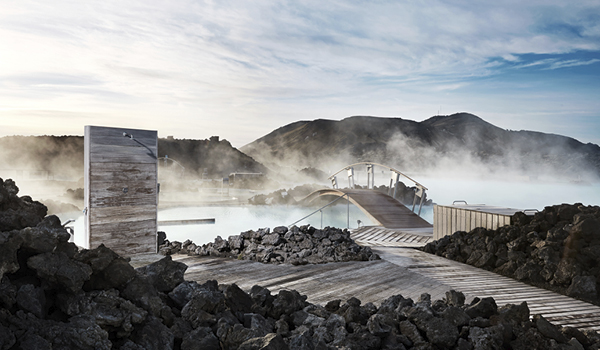
Cast out on the Reykjanes Peninsula, there’s plenty to see around the Blue Lagoon if you want to make a full day of it. Lake Kleifarvatn, sitting in the jet-black landscape, hides a legendary secret – a whale-sized worm is said to drift around the deep waters, though there have been no confirmed sightings. You might not spot the whale-worm, but the black-sand shores of the lake and craggy cliffs around it are worth the stop.
At Krisuvík geothermal area, you can stroll amongst hissing steam vents and bubbling mud pots as the earth is alive with geothermal activity. Feel the rumble of the ground as you take in the dramastically colourful landscape.
The Reykjanes Peninsula is lined with small fishing villages all along the coast. Perhaps stop at Garður with its lighthouse and traditional clapboard church against the wild scenery. At the working fishing village of Grindavik, the fresh catch of the day is still landed at the quaint harbour and at Sandgerði fishing boats still bob in the water. The tip of the peninsula is where bird cliffs rustle with life and plunge down to a lavafield moonscape as the wild North Atlantic crashes against the shore. Here you might spot kittiwakes, arctic terns and razorbills. Experience all this in one day and then unwind in the Blue Lagoon afterwards on the Reykjanes & Blue Lagoon day trip.
It’s easy to see why the Blue Lagoon is one of Iceland’s most popular attractions. It combines the other-wordly landscape that defines this island with a luxurious bathing experience. In winter, there’s little better than soaking in the bath-warm water as the snow falls around you and the Northern Lights put on a show above. Those arriving from a long-haul flight can soothe weary muscles and unwind before embarking on their Icelandic adventures and it’s the perfect way to end a day of sightseeing on the Golden Circle or Reykjanes Peninsula. Visit the Blue Lagoon to embrace Icelandic bathing culture and soak in the glorious landscape at the same time.
Tours in the spotlight
7 Tours
REYKJAVIK EXCURSIONS BLOG
Get inspired! Information and tips and must see places in Iceland, fun facts, customs and more.
Litli-Hrútur Eruption 2023 - The New Eruption near Fagradalsfjall on the Reykjanes Peninsula
Once again, the enthralling spectacle of Iceland's Reykjanes volcano is back in the limelight! After 11 months of peaceful dormancy, the volcano is now alive and kicking, treating locals and tourists to another captivating visual performance. If you've been yearning for an adventure that's truly out of this world, this might just be your calling!
Read BlogIceland’s Blue Lagoon – Your Complete Guide
March 23, 2022
Iceland’s Blue Lagoon – Your Complete Guide
March 23, 2022
Out in the volcanic landscape of the Reykjanes Peninsula, an ethereally blue geothermal lagoon awaits. People have been flocking to the warm waters since 1981 to heal their ailments and unwind weary muscles and it’s now one of Iceland’s top activities. Blue Lagoon tours head to this beautiful site, so you can enjoy an iconic Iceland experience without having to worry about logistics. Blue Lagoon tours in Iceland leave from Reykjavik or Keflavik Airport, or can be incorporated as part of a day of sightseeing. Whether you’re visiting for a stopover between continents or here to enjoy Iceland’s unique scenery in-depth, don’t leave without experiencing the geothermal waters of the Blue Lagoon. Here’s everything you need to know about it.
What is the Blue Lagoon?
Catching a glimpse of the milky-blue water against the black-rock lava fields, it may not come as a complete surprise that the Blue Lagoon is man-made. Runoff water from the nearby Svartsengi geothermal power plant trickles into the lava fields and a blanket of mineral-rich mud lines the foundations of the Blue Lagoon. This creates a heavenly bathing experience with water at a consistently pleasant temperature said to rejuvenate body, soul and skin.
You can find the Blue Lagoon a forty-five-minute drive from Reykjavik, close to Keflavik Airport on the Reykjanes Peninsula. There are plenty of activities and amenities to keep you occupied for hours – restaurants, shops, spa experiences, steam rooms and, of course, soaking in the lagoon itself.
Facts About The Blue Lagoon

History of the Blue Lagoon
When the Svartsengi geothermal power plant opened in 1976, the engineers assumed that the runoff water would simply be absorbed by the porous volcanic rock around the site. Instead, a mineral-rich bed of mud settled and heated water turned milky-blue with silica pooled to create an other-worldly lagoon.
When local people started bathing here in the 1980s, there were no changing facilities or showers and they would just change in their car or brace the open air before slipping into the geothermal water. Rumours of the healing powers of the lagoon soon spread – those with psoriasis swore it healed their skin. Even people without an affliction said they emerged fresh and baby-skinned from the warm lagoon.
1992 saw the Blue Lagoon Company officially emerge and bathing here was so popular that changing facilities and showers were added. When the power plant was moved, so was the lagoon and new facilities were built, turning this place into a luxurious spa-like experience with fine-dining restaurants, research facilities and even a hotel.
Can you swim in the blue lagoon?
The Blue Lagoon experience is designed as a relaxing spa day where you submerge yourself in the bath-warm water and simply unwind. Although you can perhaps swim a couple of leisurely breaststrokes, it’s not suitable for vigorous exercise and too shallow to dive into. In fact, you can always touch the bottom of the lagoon standing up, so it is not like a swimming pool. The milky-blue depths aren’t clear either, so you only really want to stick your head under the water to keep warm or perhaps wash off your mud mask.
What temperature is the Blue Lagoon?
The geothermal water is between 37° and 40° C (98-104°F) but can sometimes fluctuate beyond that range. It is, essentially, the temperature of a hot tub or a warm bath. Once you’ve sat in the lagoon for an hour or so, hydrating with a bottle of water is recommended.
Does the Blue Lagoon have healing properties?
In the past, people suffering from psoriasis in varying degrees have sworn it has helped them with their disease. These claims have become more than just rumours over the years – the Blue Lagoon Company has an extensive archive of academic papers, with decades of research confirming that geothermal seawater is effective in treating psoriasis. Silica in the water is particularly good at absorbing oil, so is said to help with eczema and acne too. The Blue Lagoon geothermal spa is even officially approved by Iceland’s National Health Service as psoriasis treatment.
Silica Hotel offers psoriasis treatment packages, with floating sessions in a private lagoon supervised by a dermatologist and nurse followed by UVB light therapy and Blue Lagoon skincare products.
Skincare At the Blue Lagoon

Most visitors to the Blue Lagoon indulge in a mud mask as they bathe, and the Reykjavik Excursions’ Blue Lagoon Comfort and Premium Tours include a silica and algae mud mask, rejuvenating your skin and leaving it firmer and feeling softer. Simply slipping into the warm water and spending time soaking is said to leave skin radiant, youthful and healthy.
The Blue Lagoon Company has distilled and bottled the bioactive minerals of the mud and water. Their skincare range features algae and silica masks, serums and moisturisers so you can take a little sample of the Blue Lagoon home with you. If you forget to pick up some skincare products at the lagoon itself, don’t worry, they have shops in the centre of Reykjavik and at Keflavik Airport too.
The Blue Lagoon Experience
Most people spend between two and three hours at the Blue Lagoon, but if you want to take advantage of all the facilities you can spend longer. You’ll need to bring your own swimwear, and towels can be rented (or are included in a Reykjavik Excursions Blue Lagoon trip). Lockers are available to store your belongings while you bathe.
Once you’ve changed in the changing rooms and showered, slip into the warm water and enjoy a litany of amenities. Perhaps grab a smoothie, beer or glass of wine at the in-water bar, or pick up a mud mask from the in-water mask bar.
There’s a grotto-like steam room carved into the volcanic rock and a sauna too. Geothermal, natural steam opens up the pores and is a welcome respite from the cold in winter. If you really want to indulge, opt for an in-water massage or perhaps unwind with some float therapy. Add in a lavish meal at one of the fine-dining restaurants on top of your spa experience and you could spend the best part of a day here.
Best Time To Visit The Blue Lagoon

The thermal waters stay warm year-round, so really there’s no bad time to visit the Blue Lagoon. There’s something particularly magical about soaking in the hot water as snow falls and the Northern Lights dance above you. After a morning of sightseeing in the cold Icelandic winter, there’s nothing better than a long soak in a thermal lagoon. The longer opening hours in summer, when the sun barely dips below the horizon, allow you plenty of time to enjoy every aspect of the lagoon.
Generally, the Blue Lagoon is open all day. Opening hours do vary by season, based on weather and sunset, and are as follows:
January-May from 09:00-21:00
June from 08:00-22:00
July-August from 08:00-23:00
September from 08:00-22:00
October-December from 08:00-21:00Eating at the Blue Lagoon

There are three different dining options to choose from at the Blue Lagoon. Moss is perhaps the most refined and boasts a mention in the Michelin guide. The seasonal tasting menu changes as produce in the surrounding area ripens and is harvested. In winter, a fire blazes away in the stove at the centre of the dining room and the view is over the volcanic horizon. A set tasting menu is served like works of art on a plate – think sweeps of jus around perfectly pink cuts of lamb and scallops seared to perfection. There’s a vegan menu here too.
Lava Restaurant is another refined option with an interior hewn into an old lava cliff. A menu of traditional Icelandic cuisine is served gourmet-style, based on the finest, freshest local ingredients. Perhaps start with a garlicky langoustine soup, followed by the fresh fish of the day (landed locally at Grindavik harbour) for main. The skyr and blueberries is a healthy yet sweet way to end the meal, and it’s all paired with a view of the Lagoon as you dine. If you really want to indulge, there’s a tasting menu here too. The Blue Lagoon Premium Package includes a reservation and sparkling wine at Lava Restaurant, if you are dining.
Feed your body and soul at the Spa Restaurant, where reservations aren’t necessary. The atmosphere is a bit more laid back (it is a spa after all) – you can dine in your robe here and no one will bat an eyelid. The view is out over the Lagoon from floor-to-ceiling windows and the menu serves up healthy, wholesome food from across the globe. Think umami-rich miso soup or sea-fresh ceviche, and perhaps a refreshing hit of Icelandic berries for afters.
How To Get To The Blue Lagoon

Reykjavik Excursions run a number of Blue Lagoon trips, where transfers from Reykjavik (or even Keflavik Airport) are included. If you’ve got a late flight, you can include a visit to the Blue Lagoon in your airport transfer, hopping on the bus at Reykjavik, spending a few hours soaking in the lagoon and then transferring on to the airport for your flight.
From Keflavik Airport
If you’re arriving early into Iceland, the Blue Lagoon is just 25km from Keflavik Airport so a 20-minute transfer can see you at the lagoon straight from your flight. Slipping into the warm water, surrounded by moss and lava is the perfect tonic after a long flight and an ideal introduction to Iceland’s unique landscape. Reykjavik Excursions have a few options from Keflavik Airport, whether you’re looking for an inclusive comfort or premium package with admission included, or just transfers.
Blue Lagoon Comfort Package from Keflavik Airport
Blue Lagoon Premium Admission from Keflavik Airport
Blue Lagoon Transfer from Keflvaik Airport
From Reykjavik City Centre
From Reykjavik, it’s a 50-minute bus journey to the Blue Lagoon and Reykjavik Excursions run day trips to the Blue Lagoon with admission, mud masks and towels included or can simply arrange transfers for you. The premium package includes a reservation at Lava Restaurant, or you can opt for a day trip that includes a visit to the Blue Lagoon after you’ve seen the sights of the Golden Circle or hit the Reykjanes Peninsula by ATV, which both depart from Reykjavik.
Blue Lagoon Comfort Package from Reykjavik
Blue Lagoon Premium Admission from Reykjavik
Blue Lagoon Transfers from Reykjavik
Do I Need A Reservation For The Blue Lagoon?

The Blue Lagoon is one of the most popular attractions in Iceland and there are limited spaces every day. Booking in advance is recommended so you don’t miss out on this iconic experience. Reykjavik Excursions offer tours to the Blue Lagoon with towels, mud masks and admission included as well as transfers from Reykjavik or Keflavik Airport. Transfers and tours operate year-round and offer flexible departure times throughout the day.
Popular Attractions Near The Blue Lagoon

Cast out on the Reykjanes Peninsula, there’s plenty to see around the Blue Lagoon if you want to make a full day of it. Lake Kleifarvatn, sitting in the jet-black landscape, hides a legendary secret – a whale-sized worm is said to drift around the deep waters, though there have been no confirmed sightings. You might not spot the whale-worm, but the black-sand shores of the lake and craggy cliffs around it are worth the stop.
At Krisuvík geothermal area, you can stroll amongst hissing steam vents and bubbling mud pots as the earth is alive with geothermal activity. Feel the rumble of the ground as you take in the dramastically colourful landscape.
The Reykjanes Peninsula is lined with small fishing villages all along the coast. Perhaps stop at Garður with its lighthouse and traditional clapboard church against the wild scenery. At the working fishing village of Grindavik, the fresh catch of the day is still landed at the quaint harbour and at Sandgerði fishing boats still bob in the water. The tip of the peninsula is where bird cliffs rustle with life and plunge down to a lavafield moonscape as the wild North Atlantic crashes against the shore. Here you might spot kittiwakes, arctic terns and razorbills. Experience all this in one day and then unwind in the Blue Lagoon afterwards on the Reykjanes & Blue Lagoon day trip.
It’s easy to see why the Blue Lagoon is one of Iceland’s most popular attractions. It combines the other-wordly landscape that defines this island with a luxurious bathing experience. In winter, there’s little better than soaking in the bath-warm water as the snow falls around you and the Northern Lights put on a show above. Those arriving from a long-haul flight can soothe weary muscles and unwind before embarking on their Icelandic adventures and it’s the perfect way to end a day of sightseeing on the Golden Circle or Reykjanes Peninsula. Visit the Blue Lagoon to embrace Icelandic bathing culture and soak in the glorious landscape at the same time.
Tours in the spotlight
7 Tours
REYKJAVIK EXCURSIONS BLOG
Get inspired! Information and tips and must see places in Iceland, fun facts, customs and more.
Litli-Hrútur Eruption 2023 - The New Eruption near Fagradalsfjall on the Reykjanes Peninsula
Once again, the enthralling spectacle of Iceland's Reykjanes volcano is back in the limelight! After 11 months of peaceful dormancy, the volcano is now alive and kicking, treating locals and tourists to another captivating visual performance. If you've been yearning for an adventure that's truly out of this world, this might just be your calling!
Read Blog